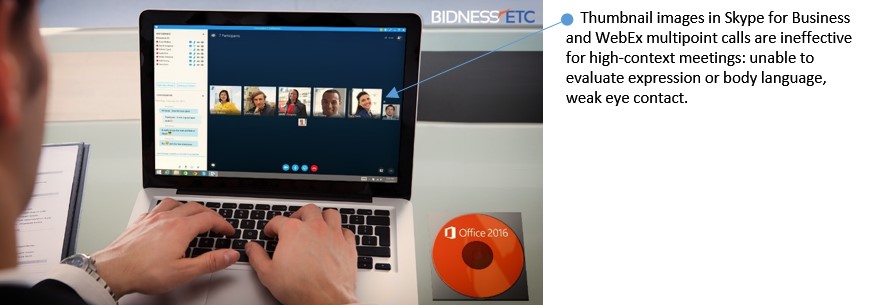Published: Sound and Communications Magazine, October 2019 https://www.soundandcommunications.com/collaboration-consulting-2020/
Integrated information, communication and technology (ICT) is the latest acronym that defines the work of consultants who are responsible for providing the design solutions and specification guidance that make enterprise spaces as functional and productive as possible. Just as our enterprise clients are, we are constantly adjusting to the metamorphosis in products, platforms, ecosystems and the user experience. Gaining a mastery of the client’s collaboration workflow and IT-network roadmap is the secret sauce to integrating technologies into the organization’s global ecosystem. That’s because today’s decisions around unified collaboration (UC) are affecting the three most significant components of any facilities project: schedule, budget and quality. Consultants have to be engaged earlier in the timeline, and we have to stay around longer to verify success.
But let’s stop the ICT rollercoaster for just a minute to enjoy the freshly brewed cup of coffee now being served up at the barista station (now an established institution inside every enterprise’s amenity space, having become equally ubiquitous as guest Wi-Fi). The enterprise message to consultants is the same: Design the most engaging spaces possible. Thus, we find ourselves in parallel trajectory with the coffee being served up right now at the espresso bar. This dark brew has an uncanny resemblance to the solutions we can expect to engineer in the meeting room. The impact on enterprise ICT consulting in 2020 is worthy of deeper consideration.
But, first, a quick coffee lesson: Brands like Folgers and Maxwell House surfaced during the first coffee wave, long before the millennium. The physical process of harvesting, roasting and delivering a consistent product was challenging—not unlike the experiences of enterprise AV consultants who struggled to solve physical design and application problems like mounting, resolutions, signal impedance and integrated services digital network (ISDN).
The second-wave coffee-roasting technologies available today are much more efficient. Starbucks and Dunkin’ can deliver a consistent experience across thousands of franchises. In our industry, second-wave enterprise designs include the transport of voice, video and content signals over unshielded twisted pair, along with remote collaboration. Cisco and Microsoft emerged as leaders because their solutions deliver a consistent user experience across their product portfolio. For their part, technology consultants have to figure out how to apply clients’ preferred platforms across the organizations’ entire campus. Each platform is essentially an ecosystem. Even though they have expanded to the internet, enterprises still have to choose between being a Microsoft or a Cisco house. Consultants have figure out how to connect these walled-off solutions with the rest of the world.
The Third Wave
What sets the third wave apart for coffee aficionados and enterprise IT managers alike is the degree to which they have both a greater appreciation for the product and a willingness to challenge the traditional ways of production and consumption. Let’s examine the third wave by breaking down its key features and their impact on schedule, quality and budget.
Schedule
Taking people’s phones away and moving to Software as a Service (SaaS) can be just as dramatic to users as removing the coffee bar. Enterprise leadership needs time to evaluate UC options and gain consensus from all stakeholders. These strategic considerations were previously upstream from the consultant brought in to build out a few floors in a new facility. Change in technology is so rapid during the third wave that strategic decisions are happening concurrently to the building out of new spaces.
Just like asking the barista, “What’s in this cup?”, IT managers are demanding a better understanding of their distinctive options. They want solutions that avoid productivity disruptions and that improve the user experience. ICT consultants must step in earlier in the design process and provide multi-dimensional comparison matrices for rapid decision-making: What happens when cloud-based voice services intersect with room meeting solutions and content collaboration? Will the newest session initiation protocol (SIP) platform work with a next-generation speakerphone? Will the wireless sharing solutions that provide both guest and employee access require security architecture review?
Fortunately, just like the physical mug that contains the coffee, the core conduit and back-box infrastructure are likely to be required in the same locations, just as the Cat6a cabling is likely to handle any variations of UC. Rack space, power and network drops are the first three requirements that must be conveyed by the consultant to the rest of the design team, so they can go off and do their designs. And, yet, these specifications are highly dependent on the enterprise standardizing on a collaboration platform.
Frequently, the consultant is brought in so far into the design phase of the project that it’s too late to flush out the client’s UC strategy. This is also when the consultant’s master plans are put to the test: Standardized products are being specified on the project. The consultant has to be engaged to advise on mocking up solutions to make sure they match the design requirements. Master plans have to include a process for modifying standards to support the rapidly changing products and features sets.
Take a sip. Can you differentiate the flavor nuances in that cup of coffee? Often underappreciated is the nuance of end-user training and its importance to overall project success. Time for it must be set aside in the project schedule. If the user struggles to operate the interface, it’s considered a poor design, even if the interface is derived from third parties such as Microsoft, Cisco or Zoom. Third-wave consultants make sure there is sufficient time for end-user training on even the most basic collaboration technologies. What’s more, what is written on the quick-reference-guide cards has to match the client’s actual use cases, rather than being generic steps from the manufacturer’s website.
In the third wave, consultant engagement extends beyond the project deadline. Six months later, they are back to verify their solutions are achieving the desired results. For instance, they’re confirming the user interface is easy to operate and there’s an increase in employee productivity. This exercise helps both the enterprise and the consultant.
Budget
How much are you willing to pay for a good cup of coffee? The consultant is responsible for matching budget and systems designs. However, the coupling across the supply chain is a third-wave distinction that make cost estimating challenging. From component manufacturer to platform provider, everything is tightly bundled. Take soundbars with built-in microphones and cameras, for instance—the consolidated hardware might have a lower cost, but there are lots of interconnecting pieces. The bundling of the SaaS subscriptions can make it difficult to unpack the actual cost for a single meeting room, particularly with a variety of add-on features available to enterprise clients in the various offerings.
A variety of USB+AV-over-IP transport solutions is emerging on the third wave, and they can scale from huddle rooms to auditoriums. The challenge for the consultant is to identify a single product line to work across all variables so that, ideally, a single management platform can be used to support the enterprise’s campus for alerting and firmware updates. Some manufacturers are charging a fee for every device that is monitored. It’s a long-term commitment, so subscriptions and other management platform dependencies have to be evaluated holistically. These are additional considerations that third-wave consultants tackle on enterprise projects.
Quality
Second-wave quality is the trade-off between time and budget; hence, the “good enough” experience at Dunkin’ is a lot like the choice to use a software application like Skype for Business instead of a dedicated videoconferencing appliance. No-cost bundled solutions inside an ecosystem like Microsoft Office have lots of appeal, but, on the third wave, high-quality video is simply expected. The latest generation of web-platform solutions delivers not only better audio and video, but also a better overall experience. Thus, the third-wave perception of quality is both tangible (image, sound and content sharing) and abstract (experience and productivity).
The Fourth Wave?
Right now, the emphasis is just as much on the café experience as it is on the double espresso shots. Third-wave collaboration vendors are competing to build the best persistent-chat and threaded-conversation platforms to bundle with their voice and video products to deliver the richest experience possible. The fourth-wave pushback might be coming soon. Enterprises might not accept a vendor’s solution if requires them to remain beholden to a single platform—particularly if it requires a dedicated computer processor in the conference rooms. Enterprises are going to want to consider lighter, more fluid alternatives. Until staff members can be as productive in a conference room as they are at their desks, enterprise managers will have to provide everyone in the office with laptops that they can bring to meetings. That significant cost could be recouped with technical advances in mobile solutions; those should ride in on the next wave.
The fourth wave of coffee is predicted to focus on the scientific aspects, such as the precise knowledge of soil and plants. Likewise, the fourth wave for collaboration technologies will focus on measurement of behaviors to improve the experience, leveraging the Internet of Things (IoT) and the vast number of components being plugged into the network. The role of the consultant will be to make sense of all that data on behalf of the client. We have to identify the core questions that enterprise managers want answered and then determine which devices must provide what type of data, and how often. The real-time reports coming out of the management platforms have to be reconfigured into trend lines so that predictive analysis can be done. That, ultimately, will help enterprise managers determine improvements for the next generation of collaboration solutions.
Conclusion
We are witnessing technology’s next evolution in the enterprise. Whether it’s at the desktop, in the meeting room or at the barista station, clients in 2020 are building communities using collaboration solutions that bring people together in ways that websites and mobile apps cannot. Second-wave products provide uniformity, but they’re restricted to a specific ecosystem. The third wave is driving the enterprise to create a consistent client experience regardless of the ecosystem, and consultants are helping to define the collaboration strategy earlier in the project schedule. Third-wave products are more accessible than ever before, and the increased focus on production quality benefits all parts of the supply chain. Enterprise clients are expecting consultants to make sense of the plethora of choices—before the fourth wave rolls in.





















